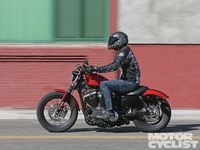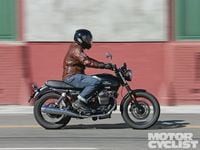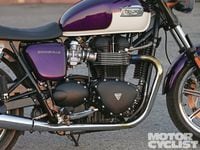An entire generation of young riders carries a deep and abiding affection for ancient, creaky bikes. They restore Hondas from the 1970s into everything from faithful, neo-NOS rides to rattle-can rat bikes, exquisite café racers to palimpsests of McQueen-era scramblers. They scour weekend swap meets for original gauges, exactly the right taillight, and myriad other elements needed to make their projects unique if not utterly authentic.
Such an aesthetic is hard to pin down—it’s as varied as the participants—but the important element is this: Styling that's simple, elemental, and functional. In general, the mechanicals should be as unencumbered by technology as possible. No one loves the sewing-machine whirr of a single-cam Honda or the pop-pop-pop of a piston-port Suzuki as much as our modern hipsters. A bike that sophisticates consider too crude to be practical is just about right.
For the rest of us who don't carry an ignition-points file on our keychains, there are these three: Harley-Davidson's Iron 883, Moto Guzzi's V7 Stone, and Triumph's Bonneville. Three brand-new, still-under-warranty throwbacks—a trio of machines that fidget out of easy classification. They're not totally about retro—though that's the main idea—and while they're not quite cruisers, they're not precisely what you'd call standards, either.
All three can play the pedigree card, but of them the Harley slaps it down the hardest. Fifty six years ago, H-D unleashed the Sportster, and while the 2013 edition is in terms of mechanical makeup and build quality dramatically far from the original, it’s an apple that landed not too far from the tree. All Sportsters are small and spare, but the Iron 883 seems smaller and sparer. All of H-D’s ’13 models are unchanged technically, which means the company brought the Iron forward with new colors, including the fantastic Candy Orange of our test bike. Contrasting with the blacked-out, crinkle-finish engine and dark, polish-highlighted wheels, this root beer-esque hue works perfectly on all three, you-bet-they’re-metal pieces that actually sport it. One of only two 883cc Sportsters this year, the $7999 Iron is The Motor Company’s low-price leader.
Moto Guzzi has the most to boast about this year, thanks to updates applied to the whole V7 lineup. According to the company, “…the V7 is a completely new bike. A more powerful, faster, smoother, ecological motorcycle that is more comfortable than previous versions.” Guzzi says the engine is “completely reengineered” this year, with 70 percent new components. It’s heavily based on the old V50 powerplant, introduced in 1977. Air-cooled heads poke out ahead of your knees and shaft final drive, absent any newfangled linkages, follows a five-speed transmission. (Shaft jacking? Man up and deal with it!)
Big news for the V7’s engine involves fresh pistons that produce a 10.2:1 compression ratio (up a whole point) and are fitted with new rings. In the V7’s Heron-style head design, changing the pistons also changes the combustion chambers. Instead of a pocket inside the head surrounding the valves, the Heron design uses a depression in the piston head as the combustion chamber. Guzzi says the new pistons help improve power and increase fuel efficiency. Heads with revised cooling fins receive fuel and air from a new single-throttle-body Magneti Marelli injection system whose ECU benefits from two oxygen sensors in the head pipes. Mercifully, they’re hidden from view, near the lower frame rail.
The Stone is a new treatment for the V7 line, featuring black-matte bodywork, dark wheels, and sparing use of chrome finishes. (The white option has a glossy finish.) The lateral tank bulges and grooved side panels are classic Guzzi. It’s a handsome interpretation of famous MG cues done with obvious care yet stylistic restraint. Turns out the Stone is the most expensive of the three here, but still a modest $8390.
Triumph had an icon in the original Bonneville and is working toward a repeat with the current bike. The re-imagined Bonnie debuted in 2001 and has undergone relatively few changes since then. Faux carburetors hiding fuel injection replaced real carburetors in 2009, two years after the original 360-degree-crank parallel twin was bumped from 790cc to 865cc. Along with injection came a new fuel tank. The current base Bonnie is Triumph’s least expensive motorcycle—a mere $7699 in single colors that include a matte-treatment Phantom Black, and $7999 in two-tone like our controversial Imperial Purple/Fusion White example.
Those are three remarkably inexpensive motorcycles by today’s economics, yet none of them looks ravaged by the accounting department. All have very nice paint, shiny chrome, and a reasonable collection of features. Sure, each gets along with a single disc brake up front, and the suspension on each offers no more adjustment than rear spring preload. Each of these urban profilers has a standard-ish riding position with a no-joke tubular handlebar and mid-mount footpegs. Although there are measurable differences in ergonomics, they’re more alike than dissimilar.
But, boy, these three couldn’t be more different in personality. In terms the Triumph would understand, like chalk and cheese. Start with the Hog. It rattles to life with all the subtlety of a pyro charge in a fishbowl. Even rubber mounted, the 45-degree V-twin rattles and rumbles in the frame, never really settling down. It bangs into first gear like dropping a sledgehammer on a welding plate. Images in the mirrors “look like an action scene from a Japanese cartoon,” says our new guy, Zack Courts. (We’re moving him up slowly from the V-Star 250.) It’s an intensely mechanical experience: The four gear-driven cams jink and jitter, the chain primary drive jingles, and you swear you can hear the rings sizzle up and down that 96.8mm bore.
Count those elements as character to camouflage the bike’s actual polish. Harley has given the 883 a slick, low-effort clutch (though the hand controls are still unaccountably large), so much flywheel that stalling is almost impossible, and the best throttle response of the three. And while the 883’s 45.9-horsepower peak is nothing special, it’s the torque curve that matters. At either end of a 47.3 lb.-ft. peak, the 883 pounds out more than 43 lb.-ft. of torque from 2100 to 5400 rpm, 400 rpm short of the rev limiter.
The Sporty’s easy to live with in an urban setting, jetting away from stoplights and maneuvering through traffic with ease. It begins to struggle elsewhere. Highway riding uncovers the bike’s awkward riding position—the handlebar is fine, but the pegs are too far forward and widely placed, a common complaint of a mid-mount setup—and buzzy nature that the rubber mounts don’t completely conceal. Short hops, fine; longer distances, forget it.
Speaking of short hops your ass will be doing plenty of those unless you live where the pavement is perfect. To achieve “the look” and a low seat height (2.2 inches lower than the next most subterranean), the Iron gets short-travel suspension that’s quickly overwhelmed by sharp-edged pavement patches, Bott’s dots, discarded bathmats, and even thick coins left on the road. Harley knows it and the aftermarket knows it: The stock Iron suspension is seriously compromised for appearances, but at least there are solutions available.
Jumping from the Harley to the Moto Guzzi requires a full recalibration of your senses. The new V7 engine promises much, but struggles to deliver. Making the least power of the three—and, yes, we recognize it is the smallest—the Guzzi’s troubles aren’t pure thrust but delivery. Slightly unpredictable, the new injection system causes the V7 to be terribly cold blooded, stall frequently, and surge at highway speeds. After a few miles you learn how much to balance the throttle and grabby clutch to keep from looking like a newbie at every stop sign. But it’s hard work.
Taking to the open road allows you to avoid the worst of the Guzzi’s fueling issues and forget for a moment the sloppy transmission, which is prone to throwing up false neutrals and is generally disagreeable. As you merge into highway traffic, the idea of emptying the Stone’s 5.8-gallon tank starts to go sour. Below 4000 rpm, the V-twin shudders between your kneecaps, threatening to walk your feet off the pegs and perpetually blurring the mirrors. Reach 65 mph, though, and the engine suddenly hits a sweet spot that continues through about 80 mph, where a new kind of vibration starts to intrude. Keep it in that range and the Guzzi is a happy puppy, though roll-on performance is nothing special—better than the Harley by a fraction but well back of the Bonnie.
An under-polished drivetrain takes away from what is actually a sweet chassis. Compared to the Harley’s, the V7’s suspension might have come off a BMW sport-tourer—it tackles large and small bumps confidently, and is sprung so the chassis has little pitching and a lot of helpful feedback. The brakes are strong and predictable, even if there’s some minor weaving evident on quick stops favoring the front brake. Oh, so this is what bias-ply tires felt like back in the day? A superbike-style bar provides more than enough leverage to flick the Guzzi through tight corners as quickly as you need to—because you’re only going to do so much with 40.5 bhp and a gearbox you soon tire of fighting.
Transfer your belongings to the Triumph Bonneville and it’s like graduating from the pull-out bed in the spare room to the master suite. Mechanically, the Bonnie is dramatically better rounded than the Harley or the Guzzi. The parallel-twin engine, massaged since its introduction in 2001 but elementally unchanged, makes the most of its 360-degree firing order (the pistons rise and fall together) and counterbalancer to provide a steady, serene sense of forward progress. Throttle response rates highly, though there is a bit more driveline lash than in the Harley. “The motor happily chugs away smoothly from stop signs with no hesitation or dips in power,” says Courts, smitten with the Bonnie’s performance but not in love with the purple paint. A light clutch pull allied to a modern-feeling five-speed transmission completes a package so at home in the city that riding to work is actually pleasurable.
In many ways, the Bonnie is deceptive. The engine doesn’t sound or feel particularly stout—and, let’s face it, 60.6 bhp is not real impressive for the displacement—but the way it moves the bike is particularly satisfying. It has a wide spread of torque and near-perfect manners, a polite humph from the exhaust, and generally feels willing to do whatever you ask. At 13.46 seconds in the quarter mile, the Bonneville can’t be called fast, but it trumps both the 883 and the Guzzi by more than a second. All of that motion comes with such a low level of vibration that a few of our guys dared to call the Bonnie dull.
Success with the engine is mirrored by Triumph’s chassis tuning. Steering accuracy, suspension compliance, and braking performance are all superior. Not to say perfect, as the Bonnie can thump you on concrete-slab freeways, but in this company the Triumph is a model of civility. At 61 pounds more than the Guzzi, the 498-lb. Triumph conceals its heft extremely well, though the winner of the “chub hider” award goes to the 564-lb. Harley.
You’ll want to take long weekends with Bonnie. As the most comfortable machine here, the Triumph can deliver you to your overnight destination without the risk of semi-permanent physical damage. (The 4.2-gal. tank and meh fuel mileage, not helped by a pessimistic low-fuel light, will keep legs in the 120-mile range.) And if you stack a few good roads between there and home, so much the better. Although the Bonneville’s cornering clearance definitely limits back road pace, it’s the only thing. The Bonnie steers with precision on the only radial tires among these three—you clearly sense the bike is capable of more if it only didn’t drag the pegs so readily.
But that's the wrong kind of thing to complain about, so the hipsters say. From a view that favors aesthetics and clarity purpose, each of these machines scores well. The Harley's stance is aggressive without venturing into outlandish, cool to the point of not caring what you think. The Guzzi, too, presses all the right buttons, and draws on its own rich history without a hint of mockery. If the Bonneville veers to the old-man side of the road-and this may be an impression strongly influenced by the purple paint; the Phantom Black Bonnie is a different animal--it at least redeems itself as by far the best functioning motorcycle in the group. How important that is to your typical hipster is anyone's guess.
Ari Henning Road Test Editor Age: 27 Height: 5’10” Weight: 177 lbs. Inseam: 33 in.
I’m a big fan of vintage bikes, but old bikes tend to break. Getting that retro look without the anachronistic technology is why these three bikes are great. The Guzzi gets a nod for style—neither the Harley nor Triumph can compete with that silhouette. Unfortunately, crappy fueling and an atrocious gearbox make the V7 fairly disappointing to ride. The Triumph has the least visual appeal (especially in purple!) but it works the best by a long shot. It makes the most power, handles well, and is comfortable enough to use as a daily rider. A pragmatic person would pick the Bonnie, but the Triumph is so practical that it’s boring. I never thought I’d say this, but I’d go with the Harley. I like the shuddering engine and the obscene mechanical noises it emanates. Plus I’d be curious to see just how much metal I could take off the footpegs and muffler!
Zack Courts Associate Editor Age: 29 Height: 6’ 2” Weight: 185 lbs. Inseam: 34 in.
I am a child of vintage racing. I grew up around finned motors and drum brakes, so in my mind all of these bikes are cool. Choosing between them is a matter of usability and fun-factor. The Harley looks great, but it’s the least comfortable by far, and sorry, I just don’t want a bike that drags its pegs leaving a gas station. The Stone is much more usable and oozes character, even if it’s a little dorky. Mostly it’s Guzzi’s “retro” transmission feel that irks me. For me, the Bonneville is the whole package. It doesn’t vibrate, the fueling is perfect, and it’s the most agile of the group. You want clatter and clunky shifting? Get an actual vintage bike. I’ll be cruising smooth on my Bonnie. And, no, it will not be purple.
Joe Neric Art Director Age: 37 Height: 5’9” Weight: 220 lbs. Inseam: 30 in.
Hands down, the Harley is the best styled bike here and would have been my pick, but the 883 Iron has issues. Starting with the name: Harley-Davidson 883 Iron. Ironic, because that’s what the suspension is made of: solid iron. Most Harleys need less, but the Iron needs more. More ride height. More suspension travel. More cornering clearance. Perhaps Harley should change the name to the 883 Irony?
What about the Guzzi? I parked it at 3rd and Traction, left the key in it, and took the bus home. It’s actually a tolerable motorcycle with some power, comfortable ergos, and it handles adequately. But the V7 Stone just doesn’t excite me. Maybe I need to be… stoned?
The race really is for second because the Bonneville runs away from the competition. It’s a complete package with retro styling, buttery smooth motor, and sporty handling. There’s a reason Steve McQueen owned one, and he’s the only guy who could get away with purple.
Arms out, feet up: That’s the Iron’s perp stance. Forward-biased, widely set footpegs drag at the slightest provocation and cause taller riders serious discomfort. Not the traveler of the group by any stretch of the imagination.
Engine type: a-c 45-deg. V-twin Valve train: OHV, 4v Displacement: 883cc Bore x stroke: 76.2 x 96.8mm Compression: 8.9:1 Fuel system: EFI Clutch: Wet, multi-plate Transmission: 5-speed Frame: Steel-tube double-cradle Front suspension: Showa 43mm fork Rear suspension: Showa shocks with adjustable spring preload Front brake: Nissin four-piston caliper, 292mm disc Rear brake: Nissin two-piston caliper, 292mm disc Front tire: 100/90-19 Michelin Scorcher 31 Rear tire: 150/80-16 Michelin Scorcher 31 Rake/trail: 30.5º/4.6 in. Seat height: 26.9 in. Wheelbase: 59.8 in. Fuel capacity: 3.3 gal. Weight (tank full/empty): 564/544 lbs. Measured horsepower: 45.9 bhp @ 5800 rpm Measured torque: 47.3 lb.-ft. @ 3800 rpm Corrected ¼-mile: 14.75 sec. @ 85.76 mph Top-gear roll-on, 60-80 mph: 9.23 sec. Fuel mileage (high/low/avg.): 55/26/37 mpg Colors: Big Blue Pearl, Black Denim, Candy Orange Availability: Now Warranty: 24 mo., unlimited mi. Contact: Harley-Davidson Motor Company 3700 W. Juneau Avenue Milwaukee, WI 53208 414.343.4056 _www.harley-davidson.com_
Moderate in every way, the Stone’s riding position works for a variety of riders. The bar width and height provides an ideal city/highway compromise, although footpegs are rather forward-set. Its tall seat might dissuade shorter riders.
Engine type: a-c 90-deg. V-twin Valve train: OHV, 4v Displacement: 744cc Bore x stroke: 80.0 x 74.0mm Compression: 10.2:1 Fuel system: EFI Clutch: Dry, multi-plate Transmission: 5-speed Frame: Steel-tube double-cradle Front suspension: Marzocchi 40mm fork Rear suspension: Sachs shocks with adjustable spring preload Front brake: Brembo four-piston caliper, 320mm disc Rear brake: Brembo two-piston caliper, 260mm disc Front tire: 110/90-18 Pirelli Sports Demon Rear tire: 130/80-17 Pirelli Sports Demon Rake/trail: 27.8º/4.3 in. Seat height: 31.6 in. Wheelbase: 57.1 in. Fuel capacity: 5.8 gal. Weight (tank full/empty): 437/402 lbs. Measured horsepower: 40.5 bhp @ 6200 rpm Measured torque: 42.1 lb.-ft. @ 2600 rpm Corrected ¼-mile: 14.39 sec. @ 85.59 mph Top-gear roll-on, 60-80 mph: 9.03 sec. Fuel mileage (high/low/avg.): 56/37/44 mpg Colors: Gloss white, matte black Availability: Now Warranty: 24 mo., unlimited mi. Contact:: Moto Guzzi USA 257 Park Avenue South, 4th Floor New York, NY 10010 212.380.4400 _www.motoguzzi-us.com_
The Bonnie’s seat is wonderfully soft, but the ergonomics are a touch odd, with bars that bring the grips in a little close and comparatively little leg room. Overall, the position works, but orangutan-armed riders might feel cramped.
Engine type: a/o-c parallel-twin Valve train: DOHC, 8v Displacement: 865cc Bore x stroke: 90.0 x 68.0mm Compression: 9.2:1 Fuel system: EFI Clutch: Wet, multi-plate Transmission: 5-speed Frame: Steel-tube double-cradle Front suspension: Kayaba 41mm fork Rear suspension: Kayaba shocks with adjustable spring preload Front brake: Nissin two-piston caliper, 310mm disc Rear brake: Nissin two-piston caliper, 255mm disc Front tire: 110/70R-17 Metzeler ME Z2 Rear tire: 130/80R-17 Metzeler ME Z2 Rake/trail: 27.0º/4.2 in. Seat height: 29.1 in. Wheelbase: 58.6 in. Fuel capacity: 4.2 gal. Weight (tank full/empty): 498/473 lbs. Measured horsepower: 60.6 bhp @ 7300 rpm Measured torque: 46.5 lb.-ft. @ 6700 rpm Corrected ¼-mile: 13.46 sec. @ 96.43 mph Top-gear roll-on, 60-80 mph: 7.28 sec. Fuel mileage (high/low/avg.): 44/34/39 mpg Colors: Aurum Gold, Crystal White, Intense Orange/Phantom Black, Imperial Purple/Fusion White, Phantom Black Availability: Now Warranty: 24 mo., unlimited mi. Contact: Triumph Motorcycles of America 385 Walt Sanders Memorial Dr. Newnan, GA 30265 678.854.2010 _www.triumphmotorcycles.com_

























/cloudfront-us-east-1.images.arcpublishing.com/octane/KIX5O23D5NAIBGFXBN3327DKZU.jpg)
/cloudfront-us-east-1.images.arcpublishing.com/octane/7GJYDUIPXRGMTMQKN6ONYOLBOU.jpg)
/cloudfront-us-east-1.images.arcpublishing.com/octane/MUQLOVLL2ZDGFH25ILABNBXKTI.jpg)
/cloudfront-us-east-1.images.arcpublishing.com/octane/TNOU5DNE2BC57MFPMGN2EIDXAM.jpg)
/cloudfront-us-east-1.images.arcpublishing.com/octane/GTCXACQGJ5HAPDTGWUQKDEH44E.jpg)
/cloudfront-us-east-1.images.arcpublishing.com/octane/S35YGSEMEZB4BLTDJTSZPF4GLA.jpg)
/cloudfront-us-east-1.images.arcpublishing.com/octane/5UOT6HPX2JFMRJAX6EH45AR4MQ.jpg)
/cloudfront-us-east-1.images.arcpublishing.com/octane/OKWOJWAKP5EP3OACCRRWPCIX2Q.jpg)
/cloudfront-us-east-1.images.arcpublishing.com/octane/2WF3SCE3NFBQXLDNJM7KMXA45E.jpg)
/cloudfront-us-east-1.images.arcpublishing.com/octane/G4MG6OUCJNBSHIS2MVVOTPX65E.jpg)
/cloudfront-us-east-1.images.arcpublishing.com/octane/IIGGWFOTOJGB7DB6DGBXCCMTDY.jpg)
/cloudfront-us-east-1.images.arcpublishing.com/octane/QSTCM6AVEZA5JJBUXNIQ3DSOF4.jpg)
/cloudfront-us-east-1.images.arcpublishing.com/octane/U4I7G625B5DMLF2DVIJDFZVV6M.jpg)
/cloudfront-us-east-1.images.arcpublishing.com/octane/B6XD6LS6IVCQPIU6HXDJSM3FHY.jpg)
/cloudfront-us-east-1.images.arcpublishing.com/octane/ICL63FEDDRDTTMINYICCEYGMDA.jpg)
/cloudfront-us-east-1.images.arcpublishing.com/octane/FCGZHQXRBZFLBAPC5SDIQLVF4I.jpg)
/cloudfront-us-east-1.images.arcpublishing.com/octane/WNOB6LDOIFFHJKPSVIWDYUGOPM.jpg)

/cloudfront-us-east-1.images.arcpublishing.com/octane/X33NU3E525ECRHXLNUJN2FTRKI.jpg)
/cloudfront-us-east-1.images.arcpublishing.com/octane/6KKT5NNL2JAVBOXMZYS5ZO76YA.jpg)
/cloudfront-us-east-1.images.arcpublishing.com/octane/J5RKG5O455GMPGQRF2OG6LRT7A.jpg)
/cloudfront-us-east-1.images.arcpublishing.com/octane/GX2CIZKQVRH2TATDM26KFG2DAE.jpg)
/cloudfront-us-east-1.images.arcpublishing.com/octane/ZWIDYSAKQZHD5BHREMQILXJCGM.jpg)
/cloudfront-us-east-1.images.arcpublishing.com/octane/CYUHJZCTSJCH3MRAQEIKXK7SCQ.jpg)